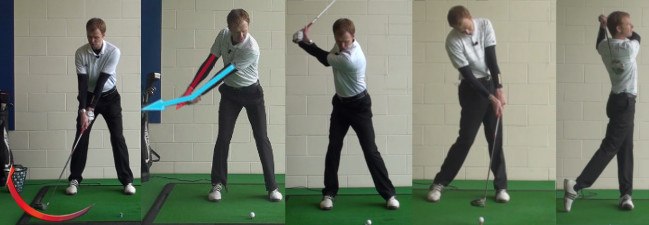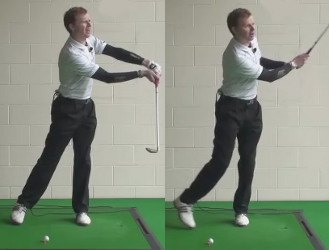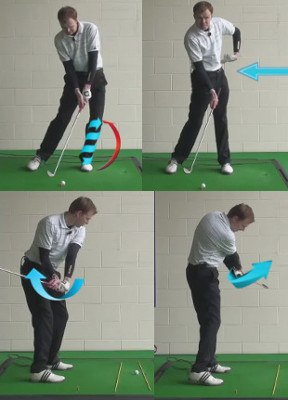
Nod if this scenario sounds familiar:
You're on the tee of an insanely tight hole – water down the left side, sand and trees hard against the right. Maybe you've got a little something on the line with a playing partner; perhaps you're competing in a tournament. Bottom line: You absolutely must get the ball in the fairway, which appears smaller every time you glance up.
You pick your target, line up precisely, swing and make solid contact. The next sound you hear is a golf ball rattling through boughs. You pushed it.

It seems like you did everything right leading up to the swing. So what happened? Chances are, you gripped the club a little more tightly than usual and tried to steer the ball into the fairway. This tension inhibited your release just enough to prevent the clubface from squaring up at impact. Hello, right woods.
If you have a habit of pushing the ball in pressure-packed situations or on difficult holes, you're probably guilty of trying to guide the ball to safety. It's important to stay relaxed and make a full, free swing – you've got to trust your skill in these spots.
It may help to gear down a club or two – hitting a 3-wood or hybrid instead of a driver, for example. This will give you more confidence in finding the fairway, and it's OK to trade a little distance for accuracy.
Next time you're under the gun, make a few long, loose, easy practice swings before going into your regular routine. Make a point to roll the right hand over the left to emulate the release you want. Remember, the only thing you have to fear is fear itself.

To Help Stop Pushing, Don't Steer Your Shots
For a right-handed golfer, a pushed shot is one which sails out to the right of the target. This kind of shot is not to be confused with a slice, which is a ball that curves dramatically from left to right. Instead, a push usually flies pretty straight – it just starts to the right of the target and then stays there until it comes down. While it might not be as ugly as a slice, the result is pretty much the same. Your ball is way right of the intended target, and you have to hit some type of recovery shot to get back in position.
In this article, we are going to offer some tips which will hopefully help to eliminate the push from your game. While there certainly are some technical problems which can lead to a pushed golf shot – and we will discuss those briefly – you can also wind up with pushed shots as a result of improper thinking. Most of the content in this article is going to be dedicated to the mental side of your game, as that is where the correction for pushed shots is going to be found for many players. If you can fix the way you are thinking both before and during your swings, your pushed shots may quickly become a thing of the past.
Before you can start trying to correct the problem of pushed shots, you have to realize that you have a problem in the first place. This is why it is so important to pay close attention to your game as you move around the course. Many golfers are too emotional as they play, and those emotions get in the way of making rational observations. For example, if you see that your ball is sailing out to the right of your target, what is the first thing you do? For many golfers, the answer is turn away from the shot, not wanting to watch their mistake in flight. By turning away, you will miss out on a chance to gather valuable information. Yes, you already know your ball is going to miss to the right, but what is it doing in the air? Did you hit a push, or a fade/slice? You need to know exactly what happened if you are going to be able to correct it properly.
Removing emotional reactions from your game can help you regardless of the setting. You will be able to watch your ball fly and learn more about your swing, and you will also gather valuable information while on the greens. It is common for players to start walking toward the hole when they see that a putt is going to miss, but again, you will miss important info that way. Stand in place, watch the ball until it has finished rolling, and then move on. By seeing what break the ball took as it rolled, you can adjust your read for future holes. No matter what part of the game is in question, paying attention and keeping your emotions in check is an important step.
All of the content below is written from the perspective of a right-handed golfer. If you happen to play left-handed, please take a moment to reverse the directions as necessary.

The Technical Issues Related to a Push
As mentioned earlier, most of this article is going to be dedicated to your mindset before and during the swing. Fixing the way you think could very well correct your pushed shots without any mechanical adjustments. However, before we get to the mental side, we do need to hit on three quick technical issues which may be leading to the push. If these technical problems are in place, it won't matter how well your mind is working because you won't be able to deliver the club to the ball properly at impact.
Review the three points below and compare them to your own swing to see if you have a problem which needs correcting.
- A short backswing. You probably think about making a long backswing first and foremost because it can help you to create power. That is true, but it does much more. A long, fluid backswing also helps your timing, allowing you to deliver the club face in a square position at the moment of contact. When you cut the backswing short, your body won't have time to get into position on the way down, and the club will often be left hanging open as a result. In the end, you hit a big push out to the right, and you are frustrated with your game. By lengthening your backswing a bit, the timing of your swing should come together and your ball striking should improve. Note – you don't have to make an incredibly long swing to see improvement. As long as you give your body enough time to get in position on the way down, you should be in good shape.
- Too quick with the lower body. This is a mistake which is usually made by professional golfers rather than amateurs. It is seen from time to time in the amateur game, however, so it is worth mentioning here. On the way down toward impact, your lower body should be leading the way by rotating toward the target. This rotation is a good thing indeed, as it leads to power generation that would not be possible otherwise. However, if you let your body get too far out in front of the swing, the club face will be stuck open at impact and the shot will be a push. Many golfers refer to this mistake as 'getting stuck', which is probably something you have heard from time to time while watching golf on TV. The only way to save your shot when you are stuck on the downswing is to flip your hands at impact – unfortunately, that move is likely to lead to a hook unless you time it just perfectly. Work on slowing your body down so you can sync everything up nicely at the bottom of the swing.
- A weak grip. If you are hitting a persistent push, the necessary correction may be as simple as a grip change. Playing with a weak grip is most comfortable for some golfers, but that weak grip can lead to trouble as the club moves through the hitting area. Without enough release to square the club face, the club can stay open through impact and a push will result. Try turning your grip into a slightly stronger position to encourage a bit of release at the bottom. It shouldn't take much of a change in your hand position to alter the way the ball flies after it leaves the club.
If you suspect that it is a technical flaw in your swing which is leading to your pushed shots, take a close look at the three points above during your next trip to the practice range. Of course, you should never expect immediate results in this difficult game, so plan on putting in a little bit of time and effort before your ball flight straightens out. If mechanical changes aren't doing the job, it may be time to consider your mind as the source of the problems.

Trying to Steer the Golf Ball
In the title of this article, we alluded to the idea that you need to stop trying to steer the ball if you want to eliminate your push. What does it mean to 'steer' the ball? Basically, this term is used when a golfer is too careful through the hitting area. Rather than trusting his or her swing and letting the club head rip through the ball aggressively, a player trying to steer his or her shots will be guiding the club at the point of contact.
This is a problem for a number of reasons. For one thing, you will lose power this way. The club head is going to lose speed as you attempt to steer it down the line, so your shots will not live up to their distance potential. With a driver, that may mean losing five or ten yards off your tee shot. With an iron, that could mean the difference between hitting the green or winding up in the front bunker. In addition to lost yardage, you will also find that a push becomes far more likely when you steer your shots. As the club comes down toward the ball, it should be naturally 'releasing' to the left – in other words, the club face should be closing down while the club rotates around your body. When that happens, you stand a good chance of delivering the club to the ball in a square position.
By trying to steer the shot, you are going to interrupt that rotation. The releasing of the club head will be slowed down by your hands, and the face will remain open at impact. With an open face, the shot is almost certain to miss to the right. During the swinging action, this isn't going to feel like much. The swing happens too fast for you to notice too many different sensations as you go. So, to make sure you aren't trying to steer the ball, you need to have your mind in a good place before the swing even begins.
The act of steering a shot is a result of low confidence. When you stand over the ball, much of the hard work for the shot should already be done. You should have a target in mind, you have obviously picked out your club, and you should know what kind of ball flight you are attempting to use. If you believe in all of those decisions completely – and you believe in your swing – you will just let it go and expect a good outcome. On the other hand, if there is doubt lingering anywhere in that process, you may wind up steering the ball toward your target. Steering the shot may feel safer than using a full release at the time, but the results are almost always forgettable.
If you are going to get away from the habit of steering your shots, you have to find a way to believe in your game. You need to trust both the decisions that you are making and the swing you have brought with you to the course. Golf is hard enough for a confident player – it is nearly impossible for a player who doesn't believe they have what it takes to get the job done. We know that confidence can be hard to find for the average amateur player, but locating it is one of the biggest keys to your improvement in this game.

Building Your Confidence
We have established that you need to be confident in your game in order to stop steering your shots. So where do you find that confidence from? This is always a bit of a 'chicken and egg' kind of question, as you need confidence to play well, but you need to play well in order to have confidence. In the points below, we offer some advice on how you may be able to build up the confidence you have in yourself on the course.
- Spend plenty of time on the range. The driving range is the best place to build confidence in your game. If you are willing to invest some time working on your game on the range, you will naturally be more confident when you return to the course. Since you are able to hit a large number of shots in a short amount of time, you should be able to develop trust in your technique much faster on the range than during an actual round. Also, by hitting a significant number of shots, you are bound to hit some good ones along the way – and those good ones will act as proof that your swing can produce nice results. Make an effort to remember those good range shots as clearly as possible and then call on those memories when you feel your confidence dip on the course.
- Create a reliable pre-shot routine. One of the most powerful things you can do for your confidence is to build a pre-shot routine that you can use time after time to put yourself in a comfort zone. A pre-shot routine is just as it sounds – it is a process that you use to prepare yourself for every shot. The contents of such a routine will vary from player to player, so feel free to build yours in a way that suits your needs. How does this help your confidence level? By giving you comfortable feelings and putting you in the right mindset to make a swing. No matter what kind of shot you may be facing, you can draw comfort from going through your routine. In many ways, a good routine can level the playing field in terms of hard shots and easy shots. Your routine doesn't know what kind of hazards may be lurking up by the green – so stick with it and you can 'trick' your mind into treating all shots as equal.
- Keep the game of golf in perspective. This tip might seem a bit odd at first, but hear us out. If you make golf more important than it really is, you are likely to get nervous and have problems with your confidence. At the end of the day, this is just a game, and it should be treated as such. Imagine for a moment that you hit your ball into the water instead of landing it safely on the green – so what? Sure, you would have liked to hit a better shot and recorded a lower score, but it's just a game. You can still have fun with your friends, get some exercise, and enjoy the outdoors – even if you don't play as well as you had hoped. When you have perspective with regard to your golf game, you will tend to take the good with the bad and have more belief in yourself overall. There will be less stress in your game, meaning there will be less worry, and you will feel free to be confident and have fun. Gaining perspective on the course just may be one of the most powerful ways you can go about improving your performance.
Steering the golf ball is all about your mindset. If you have your mind in a good place, and you feel confident about your swing, you shouldn't have to worry about steering your shots. It is only when your confidence disappears and your nerves take center stage that you need to concern yourself with this frustrating mistake. Take some time to address the confidence issues you may be facing on the links and the problem of steering your shots could go away without any other action.

Missing Right Under Pressure
If you spend any time watching golf on TV, you have probably noticed that pro golfers tend to miss to the right when they get nervous. Why is this? Why do most of the pressure shots late in tournaments sail out to the right of the hole? It comes down to confidence, as was highlighted in the previous section. Just as is the case with amateur golfers, pro players tend to steer the club through the ball when they have a dip in confidence. And, nothing will make your confidence go down like needing to hit a great shot in order to win more than a million dollars.
This is why the best players tend to win over and over again – because they are the ones who have proven that they can believe in themselves even when the heat is on. Plenty of players can post low scores on Thursday or Friday, but it takes a championship-level player to deliver a great score on a Sunday afternoon.
So what does all this have to do with you and your game? You need to keep in mind the tendency to miss right under pressure when you start to get nervous on the course. You probably won't be playing for millions of dollars anytime soon, but you still want to win when competing against friends or others at your club. When facing a particularly important shot, remember that you are likely to hold the face open and miss right. To counteract this common problem, make an effort to release the club slightly more aggressively through the ball. It takes a steady nerve to go through with this kind of swing under pressure, but you will usually be rewarded with an excellent shot.
The concept of missing right under pressure is not reserved for the full swing alone. This also applies to your putting stroke. When facing a short putt which has major implications on your round or on the competition, you are likely to hold the face open again. In this situation, the best thing you can do is focus on your right hand. Let your right hand release slightly through the ball to square up the blade and hit a great putt. You don't need to be too aggressive with this move, of course, as doing too much with the right hand will cause you to hit the putt too hard. Just let the right hand swing through a little extra and you should nail those short, scary pressure putts.
The problem of pushing the ball is not as common in the amateur game as the slice, or even the hook, but it is a problem nonetheless. To get your game on track and eliminate the push once and for all, use the advice we have provided above. The combination of mental and physical adjustments we offered should be more than enough to straighten out your ball flight nicely. Golf will be more fun when you stop missing to the right, and your scores will come down as well. Good luck!






